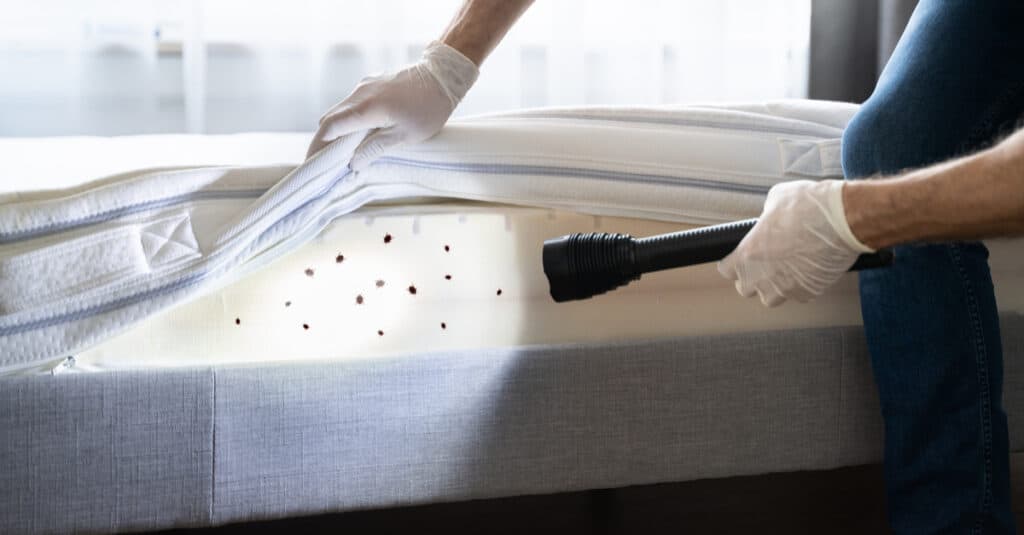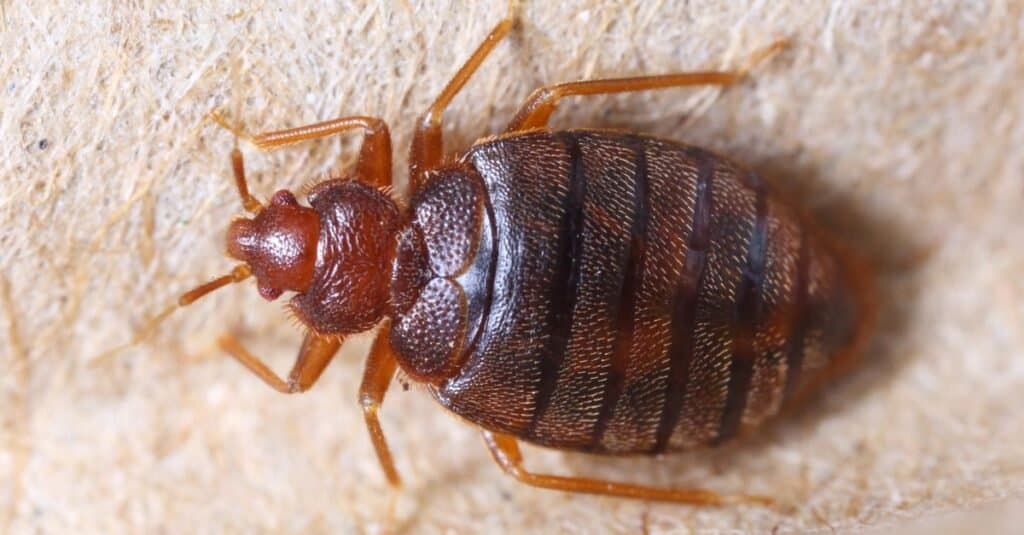The bed bug is a small blood-sucking insect that infests homes and feeds on humans. The adults are characterized by a kind of flattened oval-shaped body with a sharp beak to puncture the skin. When they feed on human blood, their bodies inflate like a balloon and turn from brown to red. But what causes bed bugs?
Bed bugs are very hard to get rid of because they like to hide in small spaces such as wall cracks, floors, or mattress seams during the day and then come out at night to feed. If you are battling a current bed bug infestation consult this guide for bed bug removal. Their bites can cause pain and swelling symptoms all over the skin. Bed bugs are native to most areas of the globe and appear to spread quickly from increased human travel. This article will cover some important facts about identification, prevention, and the ultimate cause of bed bugs.
What Causes Bed Bugs?
Contrary to some popular opinions, bed bugs do not appear to be caused by poor hygiene (although household clutter does give them a place to hide). Instead, the most frequent causes of a bed bug infestation are due mostly to accidental and random reasons. They are usually brought into the home by hitching a ride on infested items, including furniture, suitcases, clothing, purses, and backpacks. They can also enter the home through infected animals such as bats or birds.
Once they’ve established a foothold, an infestation can spread quickly into other areas of the home or building by traveling through walls, floorboards, and doorways. Unfortunately, living in a densely populated building or just staying too long in a dense area can increase the risk of an infestation. Such bed bug hot spots include apartments, dorm rooms, hotels, cruise ships, trains and buses, and shelters or camps. They can also easily move between people in shared laundry facilities.

©Andrey_Popov/Shutterstock.com
How Can I Prevent Bed Bugs from Entering the Home?
Prevention is always the best means of pest control. Once they’ve established a presence in your home, it requires a long and time-consuming process to get rid of them, because they are highly resistant to many forms of pest control and can go a long time without feeding. Fortunately, there are a few basic precautions you can take to ensure that an infestation never gains traction in your home. These measures do require a bit of time and effort, but they will save you from dealing with the hassle of even greater problems later on.
Hotels, lodgings, and cruise ships can, unfortunately, be hot spots of bed bug infestation. When staying in a room that isn’t your own, you may want to check the mattress seams for signs of bed bugs and their excrement. Place your luggage on tables, dressers, and other safe places instead of on the floor. When you’ve returned home from an overnight stay, you may want to check your items thoroughly for signs of a bed bug infestation.
You can then treat the items outside of the home (with extreme heat, cold, chemicals, or a vacuum cleaner) to make sure they are free of insects. Secondhand furniture or clothing is another potential source of bed bugs. Before bringing them into your home, you should always check them for signs of an infestation. Inspect every part of the furniture with extreme care, including seams, tufts, and under cushions. Knowing some facts about what to look for is a very important part of preventing an infestation.
In addition to these important precautions, you will also want to take the following steps to deny the bed bugs a means of spreading in the event of an accidental infestation. Reduce clutter around the home. Seal up any holes or crevices in the wall and floorboards to deny them easy hiding places. Move your bed at least several inches away from walls or furniture. Vacuum your windows, floors, mattress, clothing, and other items frequently, especially once you’ve returned home from a trip, and dispose of the bag immediately.
If you live in a multi-family home, then you may want to install door sweeps on the bottom of the doors to prevent the bugs from moving between rooms.
What Are Some Signs of a Bed Bug Infestation?
The most obvious sign of an infestation is usually the painful swelling bites on the exposed areas of the skin. These symptoms usually appear within a day of being bitten and go away very gradually. More serious reactions to their bites are very rare but may lead to body-wide symptoms like a fever. On the other end of the spectrum, a small minority of people may not develop symptoms at all, which can make identification somewhat difficult. That is why you should search for visual conformation of bed bugs as well. You may see the bed bugs themselves or the skin and droppings around the mattress seams and other areas of the room. This should give you just enough information to make a proper identification.
If you’re unsure whether you have an infestation, we suggest getting baited bed bug traps which allow you to capture any bugs in the area and examine them more closely the next morning. We recommend Harris bug traps, which come in a pack of 20.
- No chemical option to confirm bed bug presence
- Catches other bugs and pests as well
- Easy detection coverage for 2-3 rooms.
How Many Types of Bed Bugs Are There?

The tropical bed bug looks almost identical to a common bed bug, but its habitat is tropical regions.
©7th Son Studio/Shutterstock.com
Have you wondered how many species of bed bugs there are worldwide? More importantly, which ones are dangerous to humans? Worldwide, there are 90 known bed bug species. The good news is that only 4 of these types consume blood, with 2 varieties preferring human blood.
The bed bug you hear about most often that is a problem for humans is called the common bed bug (Cimex lectularius). The other type is the tropical bed bug (Cimex hemipterus). The main difference between the two is habitat, with common bed bugs living in any climate worldwide, while tropical bed bugs thrive in tropical climates. In the U.S., they are only found in Florida. A third type of bed bug that prefers the blood of bats to that of humans is Leptocimex boueti, a species that also prefers tropical climates.
Other types of bed bugs include:
- Bat Bug
- Poultry Bug
- Barn Swallow Bug
The photo featured at the top of this post is © jareynolds/Shutterstock.com
Thank you for reading! Have some feedback for us? Contact the AZ Animals editorial team.







